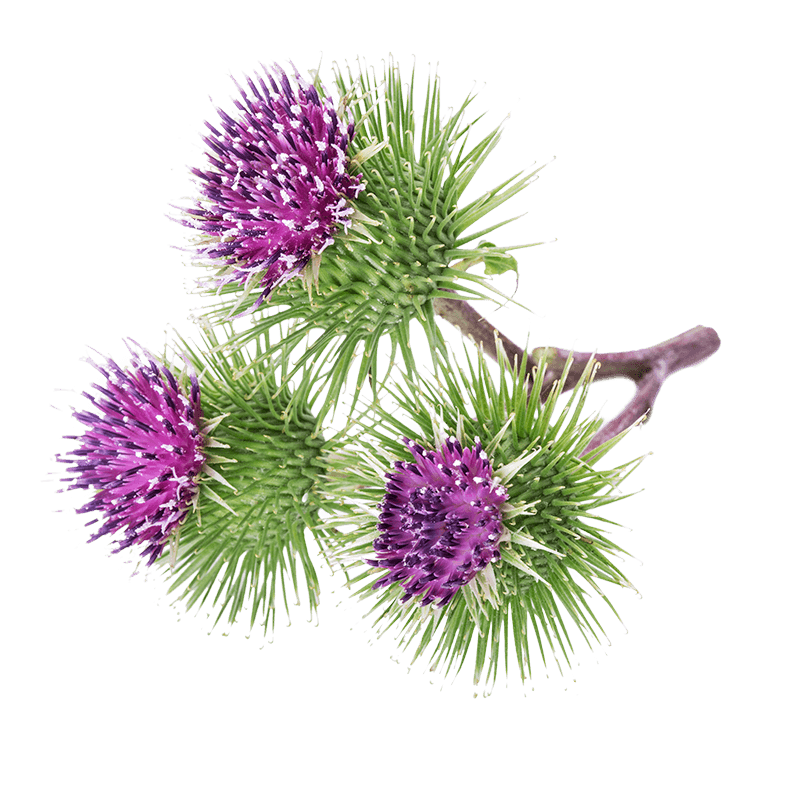
Greater burdock
Latin name
Origin
Used part
Active components
Phenolic acids (chlorogenic acid): have an antioxidant and detoxifying effect.
Lignans: contribute to the antioxidant and anti-inflammatory action.
Usage
Bibliographical references
- Anti-allergic and anti-inflammatory effects of butanol extract from Arctium Lappa L.
Sohn EH, Jang SA, Joo H, Park S, Kang SC, Lee CH, Kim SY.
Clin Mol Allergy. 2011 Feb 8;9(1):4.
Pubmed: http://www.ncbi.nlm.nih.gov/pubmed/21303540 - In vitro anti-inflammatory effects of arctigenin, a lignan from Arctium lappa L., through inhibition on iNOS pathway.
Zhao F, Wang L, Liu K.
J Ethnopharmacol. 2009 Apr 21;122(3):457-62.
Pubmed: http://www.ncbi.nlm.nih.gov/pubmed/19429312 - In Vitro and In Vivo Anti-Allergic Effects of Arctium lappa L.
Karen Knipping*,1, Elisabeth C. A. M. van Esch*, Selva C. Wijering*, Sicco van der Heide†, Anthony E. Dubois† and Johan Garssen*
Exp Biol Med November 2008 vol. 233 no. 11 1469-1477
Pubmed: http://www.ncbi.nlm.nih.gov/pubmed/18703753 - Lignans from Arctium lappa and their inhibition of LPS-induced nitric oxide production.
Park SY, Hong SS, Han XH, Hwang JS, Lee D, Ro JS, Hwang BY.
Chem Pharm Bull (Tokyo). 2007 Jan;55(1):150-2.
Pubmed: http://www.ncbi.nlm.nih.gov/pubmed/17202721 - Anti-inflammatory and radical scavenge effects of Arctium lappa.
Lin CC, Lu JM, Yang JJ, Chuang SC, Ujiie T.
Am J Chin Med. 1996;24(2):127-37.
Pubmed: http://www.ncbi.nlm.nih.gov/pubmed/8874669 - A review of the pharmacological effects of Arctium lappa (burdock).
Chan YS, Cheng LN, Wu JH, Chan E, Kwan YW, Lee SM, Leung GP, Yu PH, Chan SW.
Inflammopharmacology. 2011 Oct;19(5):245-54.
Pubmed: http://www.ncbi.nlm.nih.gov/pubmed/20981575 - Community herbal monograph on Arctium lappa L., radix
Committee on Herbal Medicinal Products (HMPC)
EMA/HMPC/246763/2009 Corr.11 16 September 2010
European Medicines Agency: http://www.ema.europa.eu/docs/en_GB/document_library/Herbal_-_Community_herbal_monograph/2011/01/WC500100388.pdf - Hepatoprotective effects of Arctium lappa Linne on liver injuries induced by chronic ethanol consumption and potentiated by carbon tetrachloride.
Lin SC, Lin CH, Lin CC, Lin YH, Chen CF, Chen IC, Wang LY.
J Biomed Sci. 2002 Sep-Oct;9(5):401-9.
Pubmed: http://www.ncbi.nlm.nih.gov/pubmed/12218354 - Hepatoprotective Effects of Arctium Lappa on Carbon Tetrachloride- and Acetaminophen-Induced Liver Damage
Song-chow Lin, Tsao-chuen Chung, Chun-ching Lin, Tzuu-Huei Ueng, Yun-ho Lin, Shuw-yuan Lin, Li-ya Wang
Am. J. Chin. Med. 28, 163 (2000).
Pubmed: http://www.ncbi.nlm.nih.gov/pubmed/10999435
The health claims that feature on our website in relation to the plants contained in our products are compliant with the list of health claims awaiting final assessment by the Community authorities (cf. website of the European Commission: http://ec.europa.eu/nuhclaims/). However, they may be subject to modification following their assessment by the national competent authorities.
The health claims relating to other nutrients or substances contained in our products that feature on our site are compliant with Regulation No. 432/2012 of the Commission of 16 May 2012 which establishes a list of authorised health claims authorised in relation to food products, other than those in reference to the reduction of the risk of disease as well as community-based development and child health (cf. website of the European Commission: http://ec.europa.eu/nuhclaims/).

 Belgique
Belgique  België
België  France
France  Italia
Italia  Portugal
Portugal  España
España  United Kingdom
United Kingdom  Κύπρος
Κύπρος 